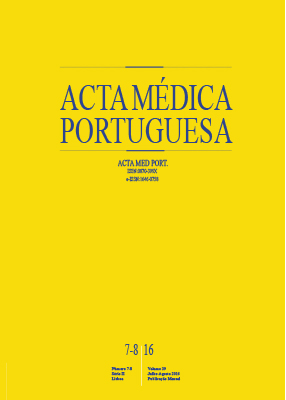Short and Long-Term Efficacy of Laparoscopic Ovarian Diathermy in Women with Polycystic Ovary Syndrome
DOI:
https://doi.org/10.20344/amp.6377Keywords:
Anovulation, Diathermy, Infertility, Female, Laparoscopy, Polycystic Ovary Syndrome, Treatment Outcome.Abstract
Introduction: Polycystic ovary syndrome is the most frequent cause of anovulatory infertility and management involves a multistep approach. Laparoscopic ovarian diathermy is accepted as a second-line treatment of patients who failed to respond to clomiphene citrate. The aims of this study were to determine the efficacy of this technique at short and long-term and to perform an analysis of predictive factors of spontaneous pregnancy.Material and Methods: This retrospective study involved 76 women who underwent laparoscopic ovarian diathermy between 2004 and 2013 in a university hospital. Main outcomes were cycle regularity and pregnancy. Short-term outcomes recorded during followup in our centre were reviewed and long-term outcomes were evaluated by a telephone interview to all women whose surgery was undertaken more than three years ago. Clinical and biochemical data were analysed as predictive factors of spontaneous conception
in patients without other infertility factors.
Results: Menstrual cycle regularity was initially achieved in 53 (70%) women and in the long-term follow-up subgroup, 52% (12/23) had regular periods. In general, 53 (70%) women conceived and 77 pregnancies were achieved, 60% of which were spontaneous. The only prognostic factor found to be significantly associated with spontaneous conception was a shorter duration of infertility (< 3 years) (p < 0.05).
Discussion: Laparoscopic ovarian diathermy showed pregnancy rates comparable to other ovulation induction treatments with the advantage of having a long lasting beneficial effect in menstrual regularity and fertility.
Conclusion: Laparoscopic ovarian diathermy is a safe and effective treatment option for anovulatory infertility in women with polycystic ovary syndrome.
Downloads
Downloads
Published
How to Cite
Issue
Section
License
All the articles published in the AMP are open access and comply with the requirements of funding agencies or academic institutions. The AMP is governed by the terms of the Creative Commons ‘Attribution – Non-Commercial Use - (CC-BY-NC)’ license, regarding the use by third parties.
It is the author’s responsibility to obtain approval for the reproduction of figures, tables, etc. from other publications.
Upon acceptance of an article for publication, the authors will be asked to complete the ICMJE “Copyright Liability and Copyright Sharing Statement “(http://www.actamedicaportuguesa.com/info/AMP-NormasPublicacao.pdf) and the “Declaration of Potential Conflicts of Interest” (http:// www.icmje.org/conflicts-of-interest). An e-mail will be sent to the corresponding author to acknowledge receipt of the manuscript.
After publication, the authors are authorised to make their articles available in repositories of their institutions of origin, as long as they always mention where they were published and according to the Creative Commons license.









